Diesel/CNG Mixture Autoignition Control Using Fuel Composition and Injection Gap
Abstract
:1. Introduction
2. Materials and Methods
3. Results
3.1. Effect of Fuel Composition
3.2. Effect of Injection Gaps
4. Discussion
5. Conclusions
- (1)
- The results showed that the fuel composition had a significant impact on the global reactivity index that later affect the combustion performance with higher pressure and THR, shorter duration, and higher combustion efficiency as compared to diesel combustion.
- (2)
- The combustion performance deteriorated with higher CNG percentages in the mixture because of the low reactivity of CNG.
- (3)
- 60/40 diesel/CNG composition shows the best output when compared to other mixture compositions as it produces higher combustion output and shorter combustion duration, even though it shows long combustion delay.
- (4)
- The primary reason for the diesel/CNG mixture better combustion output is the distributed diesel droplet caused by CNG injection that became multiple ignition points that significantly shortened the combustion duration.
- (5)
- The gap between the injections of the diesel and the CNG was found to have a diverse effect relative to the mixture compositions.
- (6)
- For high diesel percentage, the injection gaps show less effect to the combustion phasing, yet it has a significant effect on the combustion output. The combustion efficiency is reduced, and the combustion delay is longer with the increase of injection gap.
- (7)
- In contrary, for the lower diesel percentage, injection gaps show a significant effect on the combustion phasing with a longer injection gap having longer combustion duration. Despite its effect on the combustion phasing, injection gap shows less effect on the combustion output.
- (8)
- Mixture composition and injection gap are capable of controlling the combustion output and phasing as it generally creating various global and local reactivity index.
Acknowledgments
Author Contributions
Conflicts of Interest
References
- Onishi, S.; Jo, S.; Shoda, S.; Jo, K.; Kato, P. Active Thermo-atmosphere Combustion (ATAC)—A New Combustion Process for Internal Combustion Engines. SAE Tech. Pap. 1979. [Google Scholar] [CrossRef]
- Najt, D.; Foster, P. Compression-Ignited Homogeneous Charge Combustion. SAE Tech. Pap. 1983. [Google Scholar] [CrossRef]
- Lee, C.H.; Lee, K.H. An experimental study of the combustion characteristics in SCCI and CAI based on direct-injection gasoline engine. Exp. Therm. Fluid Sci. 2007, 31, 1121–1132. [Google Scholar] [CrossRef]
- Kuleshov, A. Self-Ignition Delay Prediction in PCCI Direct Injection Diesel Engines Using Multi-Zone Spray Combustion Model and Detailed Chemistry. SAE Tech. Pap. 2010. [Google Scholar] [CrossRef]
- Splitter, D.A.; Reitz, R.D.; Hanson, R. High Efficiency, Low Emissions RCCI Combustion by Use of a Fuel Additive. SAE Int. J. Fuels Lubr. 2010, 3, 742–756. [Google Scholar] [CrossRef]
- Benajes, J.; Molina, S.; García, A.; Belarte, E.; Vanvolsem, M. An investigation on RCCI combustion in a heavy duty diesel engine using in-cylinder blending of diesel and gasoline fuels. Appl. Therm. Eng. 2014, 63, 66–76. [Google Scholar] [CrossRef]
- Kokjohn, S.; Reitz, R.D.; Splitter, D.; Musculus, M. Investigation of Fuel Reactivity Stratification for Controlling PCI Heat-Release Rates Using High-Speed Chemiluminescence Imaging and Fuel Tracer Fluorescence. SAE Int. J. Engines 2012, 5, 248–269. [Google Scholar] [CrossRef]
- Pohlkamp, K.; Reitz, R.D. Reactivity Controlled Compression Ignition (RCCI) in a Single-Cylinder Air-Cooled HSDI Diesel Engine. SAE Tech. Pap. 2012. [Google Scholar] [CrossRef]
- Sjöberg, M.; Lars-Olof, E.; Eliassen, T.; Magnusson, L.; Ãngstrom, H.E. GDI HCCI: Effects of Injection Timing and Air Swirl on Fuel Stratification, Combustion and Emission Formation. SAE Tech. Pap. 2002. [Google Scholar] [CrossRef]
- Aroonsrisopon, T.; Werner, P.; Waldman, J.O.; Sohm, V.; Foster, D.E.; Morikawa, T.; Iida, M. Expanding the HCCI Operation With the Charge Stratification. SAE Tech. Pap. 2004. [Google Scholar] [CrossRef]
- Sjöberg, M.; Dec, J.E. Smoothing HCCI Heat-Release Rates Using Partial Fuel Stratification with Two-Stage Ignition Fuels. SAE Tech. Pap. 2006. [Google Scholar] [CrossRef]
- Jung, G.S.; Sung, Y.H.; Choi, B.C.; Lim, M.T. Effects of mixture stratification on HCCI combustion of DME in a rapid compression and expansion machine. Int. J. Automot. Technol. 2009, 10, 1–7. [Google Scholar] [CrossRef]
- Mukhopadhyay, S.; Abraham, J. Influence of compositional stratification on autoignition in n-heptane/air mixtures. Combust. Flame 2011, 158, 1064–1075. [Google Scholar] [CrossRef]
- Dec, J.E.; Yang, Y.; Dronniou, N. Boosted HCCI—Controlling Pressure-Rise Rates for Performance Improvements using Partial Fuel Stratification with Conventional Gasoline. SAE Int. J. Engines 2011, 4, 1169–1189. [Google Scholar] [CrossRef]
- Inagaki, K.; Fuyuto, T.; Nishikawa, K.; Nakakita, K. Dual-Fuel PCI Combustion Controlled by In-Cylinder Stratification of Ignitability. SAE Tech. Pap. 2006. [Google Scholar] [CrossRef]
- Li, J.; Yang, W.M.; An, H.; Zhou, D.Z.; Yu, W.B.; Wang, J.X.; Li, L. Numerical investigation on the effect of reactivity gradient in an RCCI engine fueled with gasoline and diesel. Energy Convers. Manag. 2015, 92, 342–352. [Google Scholar] [CrossRef]
- Li, J.; Yang, W.M.; An, H.; Zhao, D. Effects of fuel ratio and injection timing on gasoline/biodiesel fueled RCCI engine: A modeling study. Appl. Energy 2015, 155, 59–67. [Google Scholar] [CrossRef]
- Qian, Y.; Ouyang, L.; Wang, X.; Zhu, L.; Lu, X. Experimental studies on combustion and emissions of RCCI fueled with n-heptane/alcohols fuels. Fuel 2015, 162, 239–250. [Google Scholar] [CrossRef]
- Benajes, J.; Molina, S.; García, A.; Monsalve-Serrano, J. Effects of low reactivity fuel characteristics and blending ratio on low load RCCI (reactivity controlled compression ignition) performance and emissions in a heavy-duty diesel engine. Energy 2015, 90, 1261–1271. [Google Scholar] [CrossRef]
- Paykani, A.; Kakaee, A.-H.; Rahnama, P.; Reitz, R.D. Effects of diesel injection strategy on natural gas/diesel reactivity controlled compression ignition combustion. Energy 2015, 90, 814–826. [Google Scholar] [CrossRef]
- Wu, Y.; Hanson, R.; Reitz, R.D. Investigation of Combustion Phasing Control Strategy During Reactivity Controlled Compression Ignition (RCCI) Multicylinder Engine Load Transitions. J. Eng. Gas Turbines Power 2014, 136, 91511. [Google Scholar] [CrossRef]
- Kakaee, A.-H.; Rahnama, P.; Paykani, A. Influence of fuel composition on combustion and emissions characteristics of natural gas/diesel RCCI engine. J. Nat. Gas Sci. Eng. 2015, 25, 58–65. [Google Scholar] [CrossRef]
- Poorghasemi, K.; Khoshbakhti, R.; Ansari, E.; Khoshbakht, B.; Shahbakhti, M.; Naber, J.D. Effect of diesel injection strategies on natural gas/diesel RCCI combustion characteristics in a light duty diesel engine. Appl. Energy 2017, 199, 430–446. [Google Scholar] [CrossRef]
- Salahi, M.M.; Esfahanian, V.; Gharehghani, A.; Mirsalim, M. Investigating the reactivity controlled compression ignition (RCCI) combustion strategy in a natural gas/diesel fueled engine with a pre-chamber. Energy Convers. Manag. 2017, 132, 40–53. [Google Scholar] [CrossRef]
- Gharehghani, A.; Hosseini, R.; Mirsalim, M.; Jazayeri, S.A.; Yusaf, T. An experimental study on reactivity controlled compression ignition engine fueled with biodiesel/natural gas. Energy 2015, 89, 558–567. [Google Scholar] [CrossRef]
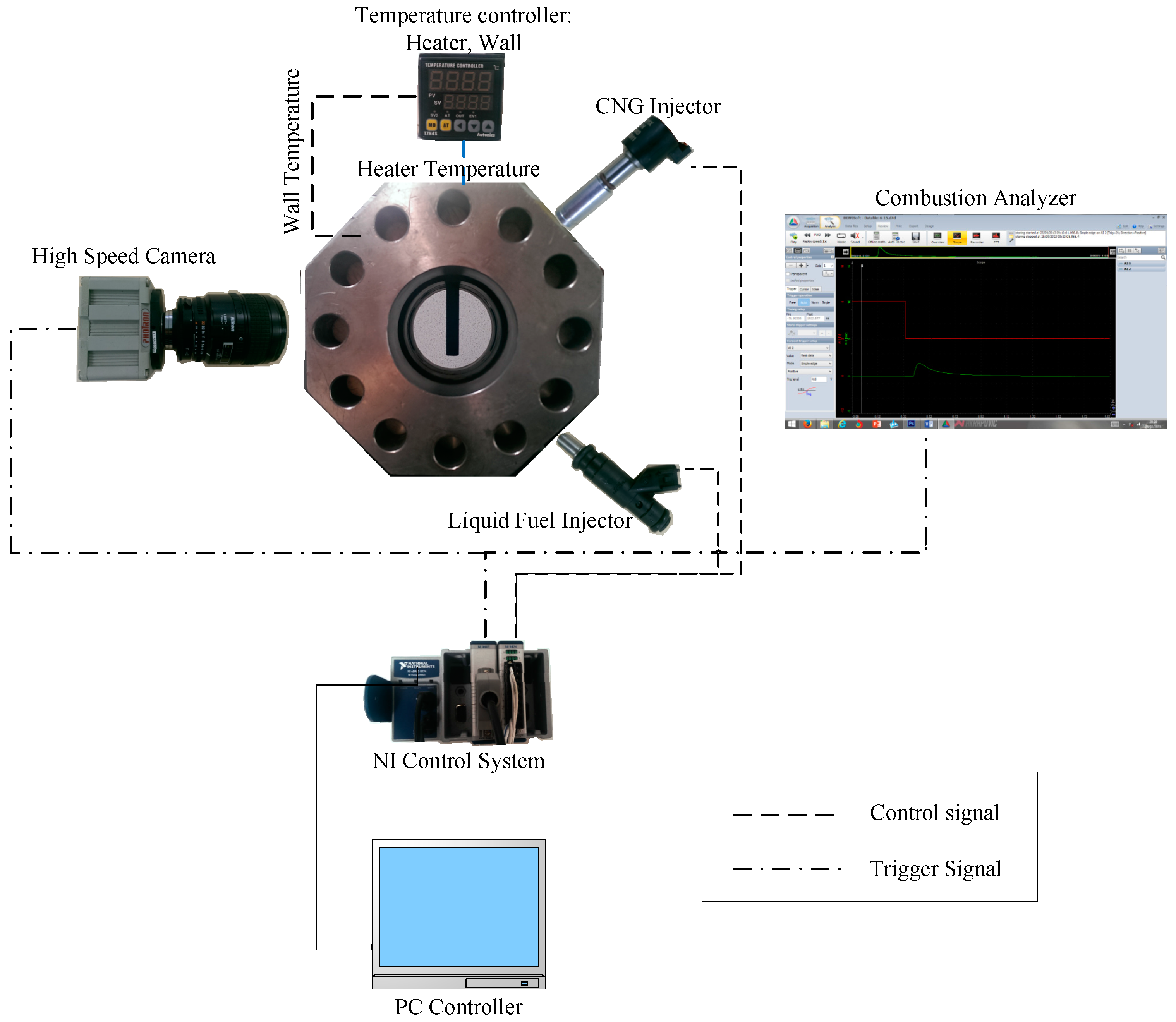
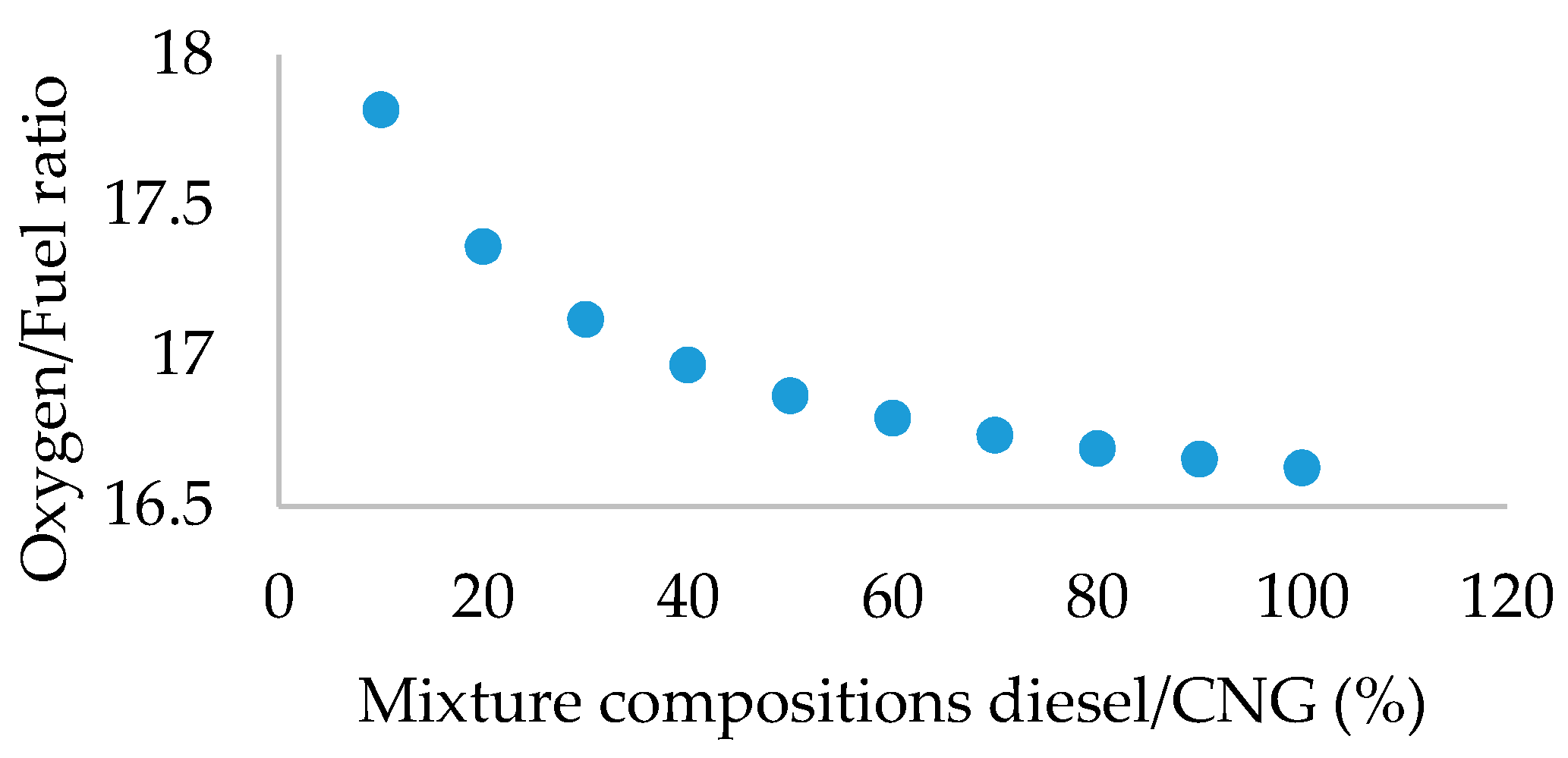

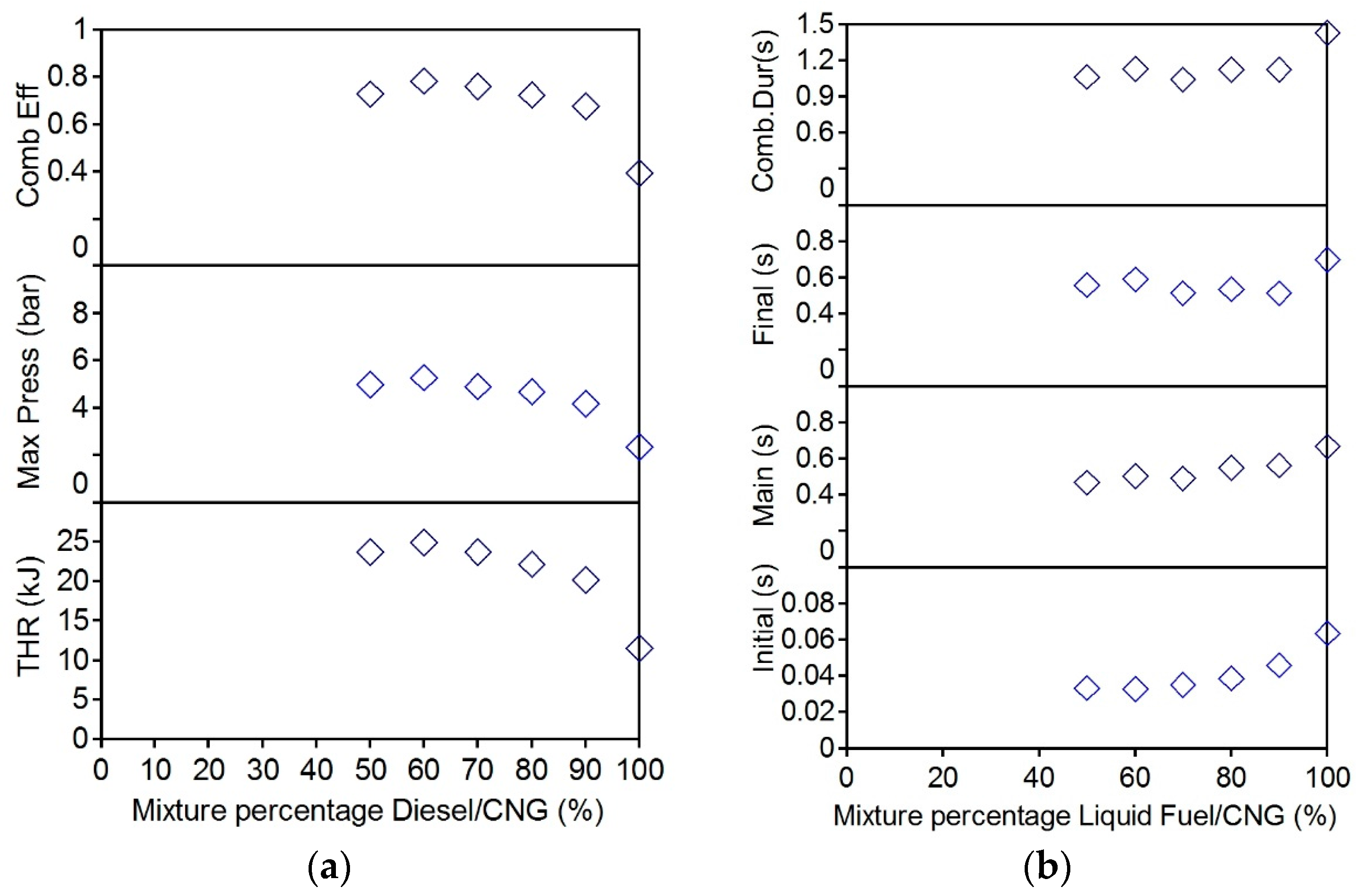

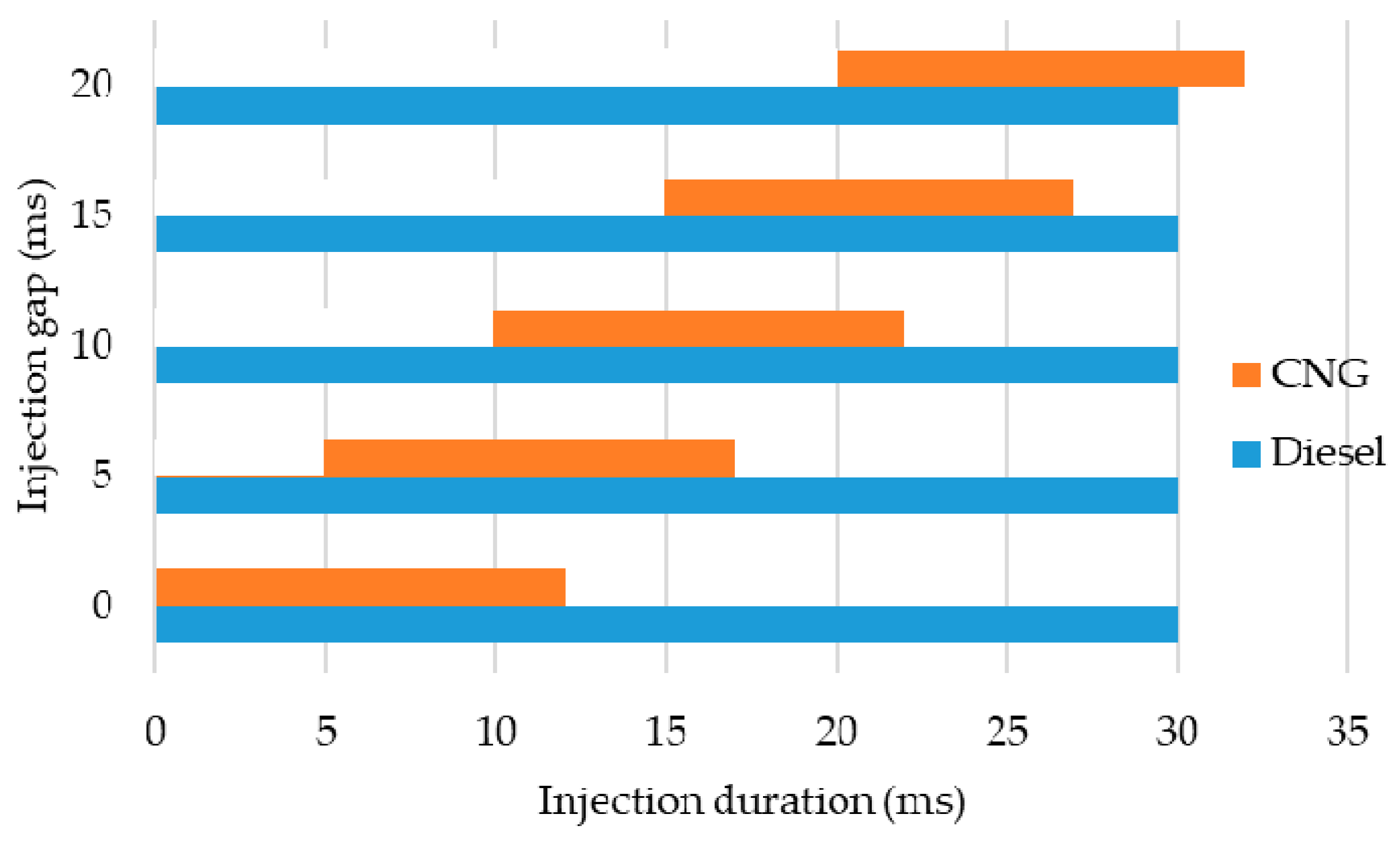

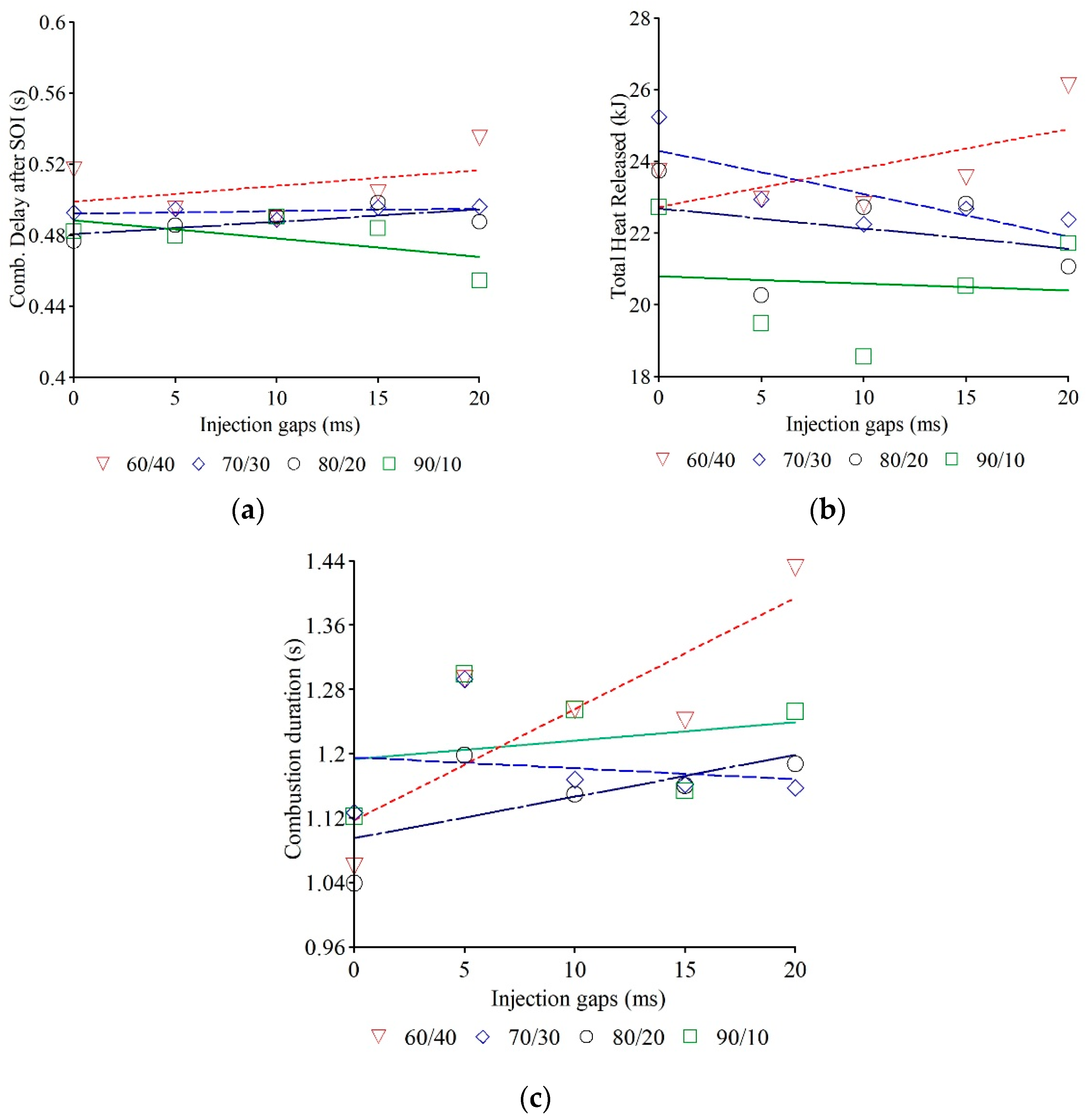

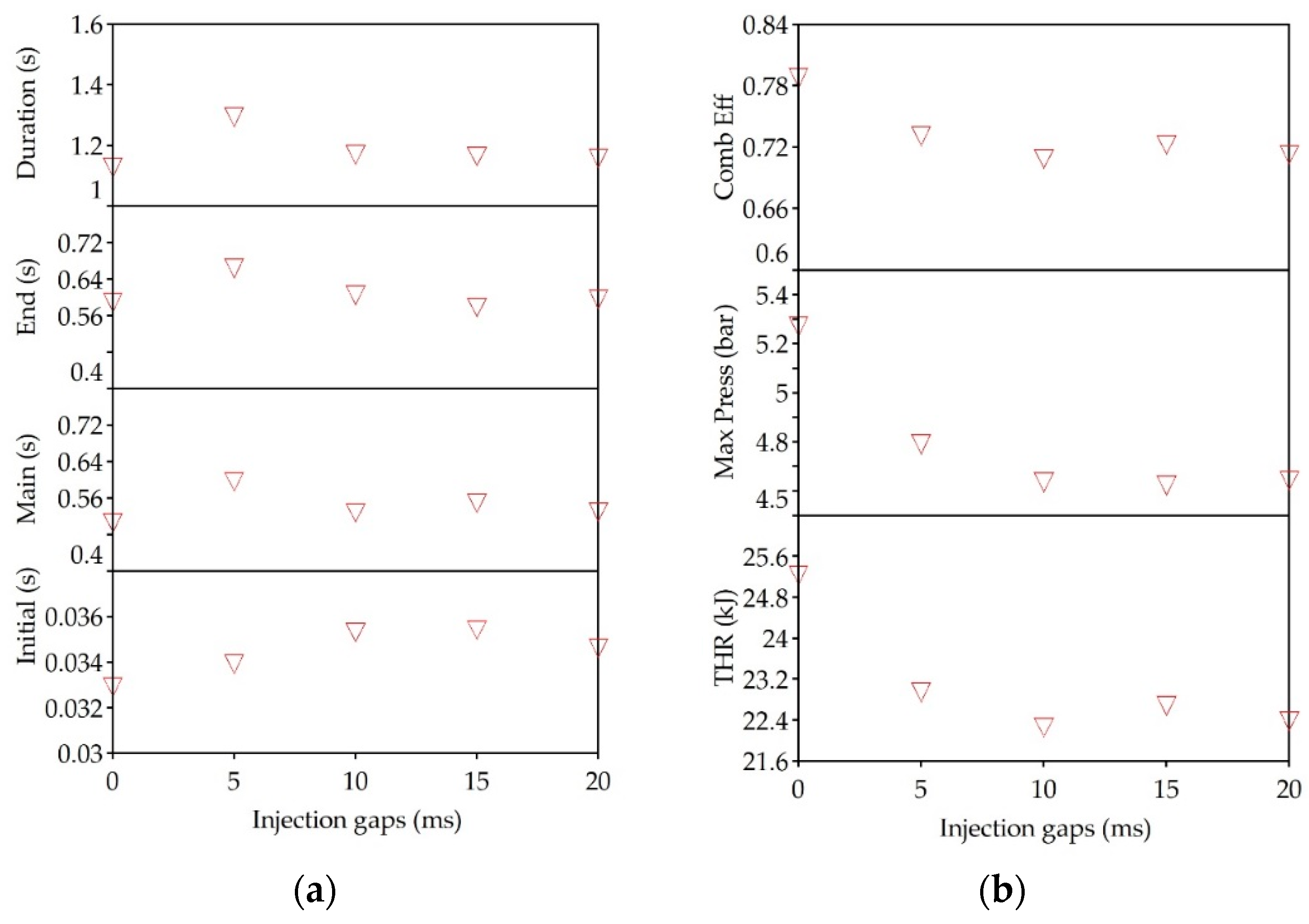

| Fuels | Injector Delivery Rate (g/s) |
|---|---|
| Diesel | 4.2 @ 3 bar |
| CNG | 7.2 @ 7.5 bar |
© 2017 by the authors. Licensee MDPI, Basel, Switzerland. This article is an open access article distributed under the terms and conditions of the Creative Commons Attribution (CC BY) license (http://creativecommons.org/licenses/by/4.0/).
Share and Cite
Firmansyah; A. Aziz, A.R.; Heikal, M.R.; Zainal A., E.Z. Diesel/CNG Mixture Autoignition Control Using Fuel Composition and Injection Gap. Energies 2017, 10, 1639. https://doi.org/10.3390/en10101639
Firmansyah, A. Aziz AR, Heikal MR, Zainal A. EZ. Diesel/CNG Mixture Autoignition Control Using Fuel Composition and Injection Gap. Energies. 2017; 10(10):1639. https://doi.org/10.3390/en10101639
Chicago/Turabian StyleFirmansyah, A. Rashid A. Aziz, Morgan Raymond Heikal, and Ezrann Z. Zainal A. 2017. "Diesel/CNG Mixture Autoignition Control Using Fuel Composition and Injection Gap" Energies 10, no. 10: 1639. https://doi.org/10.3390/en10101639
APA StyleFirmansyah, A. Aziz, A. R., Heikal, M. R., & Zainal A., E. Z. (2017). Diesel/CNG Mixture Autoignition Control Using Fuel Composition and Injection Gap. Energies, 10(10), 1639. https://doi.org/10.3390/en10101639





